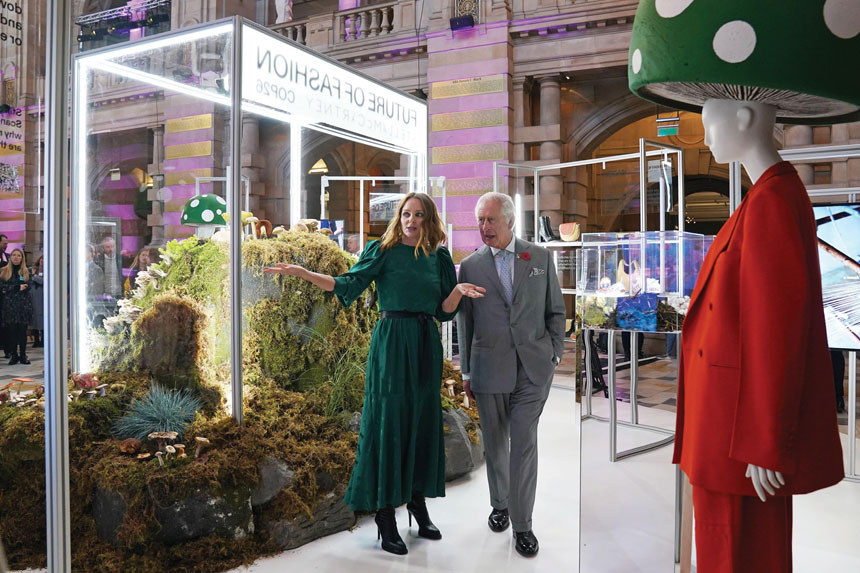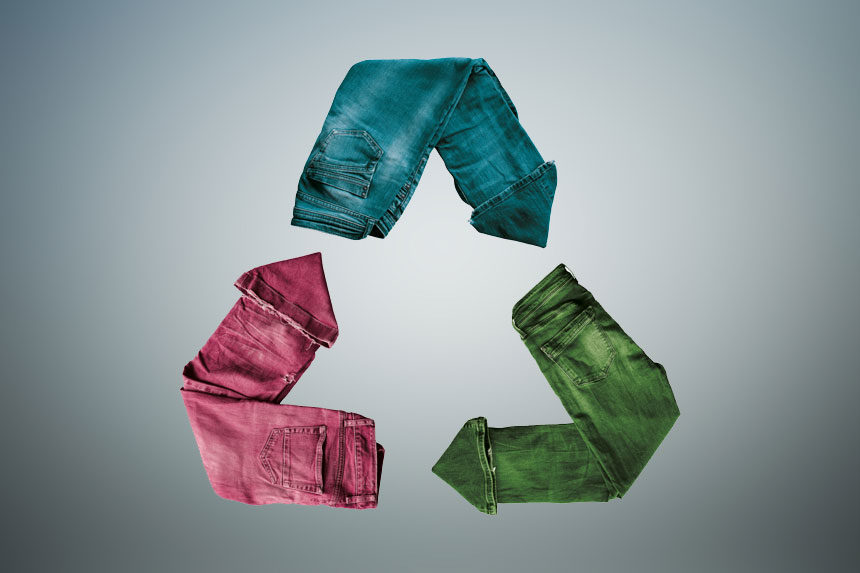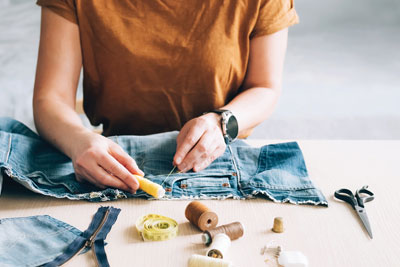Recently, I pulled a jacket from my closet, paired it with some red pants and earrings, and hit the town, which for me was going to a book-signing event. Call me wild!
That night, I got more compliments and where-did-you-get-its over this jacket than I have in years. The garment is pretty great — kimono-style in the front, cape in the back, colorful, lined, and unique. I’ll admit, too, the compliments were nice. But what felt way better was to be able to respond, “Thank you. I bought it at a secondhand boutique.”
Not only did I spend a minimal amount (less than $60 — fist pump) for a clearly fabulous find, but I also joined the ranks of consumers turning to “circular fashion” — a growing trend in refreshing our wardrobes and producing new garments in more planet-friendly ways.
Currently, there’s a huge amount of waste created in the garment industry. It produces close to 10 percent of the world’s carbon dioxide emissions and is a massive consumer of the world’s water supplies. To create a single pair of jeans, for example, requires nearly 2,000 gallons of water. And each year, around 8 billion barrels of oil are used to produce synthetics like nylon and polyester. (When washed, these materials also release harmful microplastics into the oceans.)
Consumers in America and other industrialized countries contribute to the problem, however unknowingly. We buy cheap new clothes, wear them a few times, and then toss them out. The EPA estimates that Americans discarded 16 million tons of textiles and clothing in 2018, of which only 15 percent was recycled — the rest carted off to landfills, incinerated, or exported abroad to meet similar fates.
Something’s got to give. Scientists are working to develop game-changing, carbon-negative fabrics that are less extractive and harmful, while some leading brands are shifting from linear take-make-waste economies to circular ones in which fewer garments are made, waste and pollution are vastly reduced, and used clothing is given new life rather than being dumped in landfills.
But there’s also a role for the individual in addressing the problem. It starts with making the most of what you already own: “The most sustainable garments are the ones found in our closets right now,” says Carmen Gama, director of circular design for Eileen Fisher and co-founder of Make Aneew, a company that helps brands scale their fiber recycle and resale programs. Gama suggests spending a little more for wardrobe staples made of natural fibers such as organic cotton and linen. And if that’s not economically feasible?
“Shop secondhand,” says Gama. “You’ll build an affordable wardrobe that’s better for the planet and that doesn’t look like everyone else’s.”
Demand for quality secondhand clothing is surging. According to a recent report by thredUP, the world’s largest fashion resale platform, the U.S. secondhand market is expected to more than double by 2026, reaching $82 billion.

“When it comes to consumer shopping motivations, sustainability and cost savings matter, which is driving new demand for resale. Our Resale Report data found that over half of consumers are more opposed to waste, both financially and environmentally,” says thredUP president Anthony Marino.
When thredUP was founded more than a decade ago, Marino says there was a certain stigma attached to thrift. Today, that perception is gone, and Gen Z wants to wear clothes that express their values, such as sustainability and individuality. Retailers are seeing these trends happening among their own customers too and are embracing resale.
Founded in 1984, Eileen Fisher’s designs have always been simple, timeless, and made to last. In 2009, they created their Take Back program, which invites customers to bring in their Eileen Fisher clothing, in any condition, for a $5 per item credit. To date, more than 1.6 million garments have been returned. The returns are cleaned, refashioned, or repaired, and resold under the Eileen Fisher Renew name. Pieces too damaged to be resuscitated as clothing are turned into new textiles or upcycled into home décor and accessories. Dozens of other retailers are embracing resale too, including well-known retailers Patagonia, Lululemon, Dolce Vita, Frye, and Rylee + Cru, and thredUP’s recently released comprehensive Recommerce 100 index shows the number of brand resale shops launched in 2022 is expected to exceed the number of all other resale shops launched to date.
The fashion industry, largely unregulated to date, is starting to feel pressures from policymakers, too, who are paying closer attention to circular business models. Currently pending in the New York State Senate, the New York Fashion Sustainability and Social Accountability Act aims to hold the fashion industry accountable for its climate impacts and the conditions of garment workers around the world. While consumer buying habits and legislation are a huge part of the solution, science is also making its way onto catwalks and revolutionizing the way textiles are conceived.
Haute couture label Stella McCartney has been walking the planet-conscious walk down runways since 2001, never using leather, fur, skins, feathers, or animal glues in its designs. In 2008 the company began sourcing only organic cotton, and in 2010, banned polyvinyl chloride, aka PVC, a plastic full of harmful chemicals. More than a decade later, the sustainability pioneer continues to speak up for Mother Earth. The company has eliminated mohair and virgin cashmere and introduced renewable materials for shoe soles. Stella McCartney also introduced Recycrom dye, a solution made of 100 percent recycled clothing, fibrous material, and textile scraps. This year, the brand released the world’s first commercially available handbag made of Mylo, an innovative material by Bolt Threads that’s a verified vegan, animal-free, and renewable leather alternative made from mycelium, the underground root system of fungi.

Innovation is guiding the production at Rubi Laboratories in San Francisco, too, where 25-year-old twin sisters and founders Leila and Neeka Mashouf, whose uncle founded the Bebe fashion brand, developed a way to capture carbon dioxide destined for the atmosphere and turn it into cellulose, which is then used to make a carbon-negative viscose replacement.
According to nonprofit forest and environmental advocate Canopy Planet, more than 200 million trees per year are logged (and processed with a lot of water and highly toxic chemicals) to make viscose, the third-most-used textile fiber in the world. While creating traditional viscose destroys trees, Neeka says Rubi Laboratories was inspired by how trees breathe in carbon dioxide to turn it into useful components like cellulose to build their trunks, branches, and leaves.
“What’s so exciting about our technology is that it produces the same textiles that brands are already using today. This means our materials will have the same performance and quality but with a planet-positive impact,” says Neeka, who studied materials engineering at UC Berkeley. “Being a part of both the science innovation and fashion worlds gave us the clear perspective that fashion is so ripe for disruption. We can’t name any names just yet, but we will be testing with a handful of tier-one global retail and fashion brands soon.”
Like any cultural shift that challenges status quo, change takes time, education, and will. But ultimately, it’s consumers, particularly Millennial and Gen Z, that are pushing brands to go beyond greenwashing words and demanding sustainability, transparency, and action. It’s because of them, says Neeka, the company’s CEO, that the industry is finding its way to a greener future. “Consumer preferences fuel innovation, and innovation fuels consumer preferences.”
As for my wardrobe, it’s getting greener in many ways. Not only is it my favorite color and the “it” hue for 2022, I now find myself carefully considering the need for more clothing, frequenting resale shops in different cities, and examining garment labels for taboo materials. It’s a small step, I realize. But it’s one I hope forms a habit that’s good for my closet, my pocketbook, and the planet.
Kimberley Lovato is a freelance writer based in San Francisco whose work has appeared in Afar, National Geographic Traveler, Condé Nast Traveler, and Virtuoso. To read more of her work, visit kimberleylovato.com.
This article is featured in the November/December 2022 issue of The Saturday Evening Post. Subscribe to the magazine for more art, inspiring stories, fiction, humor, and features from our archives.
Become a Saturday Evening Post member and enjoy unlimited access. Subscribe now





Comments
It’s about time. I am so impressed with this article. If everyone would finally wake up and get on the bandwagon, we can make it better for future generations. The responsibility lies with all of us.
I personally like thrifting. I like having my own style and not what’s being pushed out by the retail market.
We can do this!